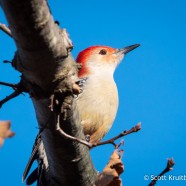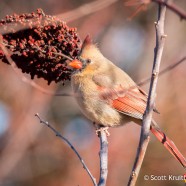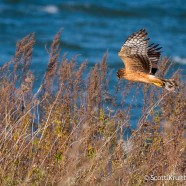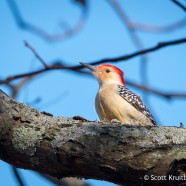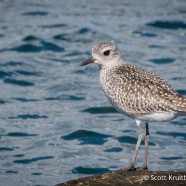Red-bellied Woodpecker
This is one gorgeous bird! It is a male Red-bellied Woodpecker enjoying the warmth of this December weekend, soaking in some sun between feeding on acorns and all sorts of natural food – which seems to be in abundance this season. Between the temperatures in this wonderfully warm stretch of weather and the varied menu to select from it is easy to see why species like this one are able to make a push further north to expand their range. The last two frigid years were an exception to the new warmer-than-average rule, and this incredible positive temperature departure is really going to...
Read MoreNorthern Cardinal
Here’s a female Northern Cardinal (Cardinalis cardinalis) enjoying another lovely November day during what was one of the warmest meteorological autumns (September, October and November) on record for our region. We often forget the familiar backyard species is another bird expanding their range northward, using the changing climate, regrowth of woodlands and expansion of suburban yard and bird feeders to their advantage in the Northeast. They do look so wonderful against a snow cover, but we may have to wait on that for a while.
Read MoreWinter Raptor Surveys Commence
With the calendar flipping into December we have now entered the winter raptor survey season! The Roger Tory Peterson Institute of Natural History will be assisting the New York State Department of Environmental Conservation for a third season of wintering raptor surveys in Chautauqua County in 2015-2016. The primary focus of these surveys is to determine where Short-eared Owls (Asio flammeus), ‘endangered’ in New York, and Northern Harriers (Circus cyaneus), ‘threatened’ in New York, are spending the winter season to roost and feed. We need your help, too! From December through March please...
Read MoreRed-bellied Woodpecker
Over the course of Roger Tory Peterson’s lifetime the Red-bellied Woodpecker (Melanerpes carolinus) pushed its typical range much further north, moving into his homes in Jamestown, New York and Old Lyme, Connecticut. This was likely due to a combination of climate change, agricultural areas and grasslands being allowed to mature into woodlands, and humans spreading into suburbs creating additional favorable habitat and feeding birds year-round in their yards. The species can now commonly be found in both of Roger’s favorite locations. This bird is a male, showing his red forehead...
Read MoreBlack-bellied Plover
Though this Black-bellied Plover (Pluvialis squatarola) is not quite living up to its name during the non-breeding season it still has a surprisingly appealing look. The plumage may initially seem dull but when it takes flight it flashes some of that namesake color with its black axillars and an always white rump and tail. The species can be found hanging out on the Atlantic Coast in many locations during the late autumn and winter. It is a bird we record nearly year-round for our work in the Audubon Alliance for Coastal Waterbirds.
Read More



